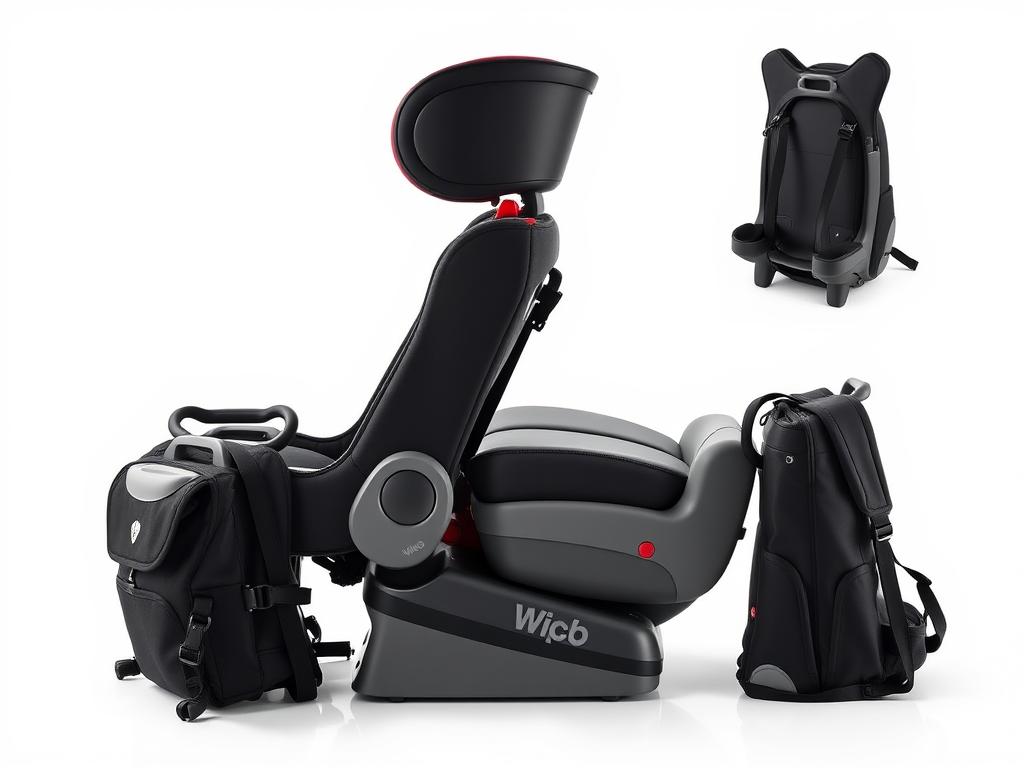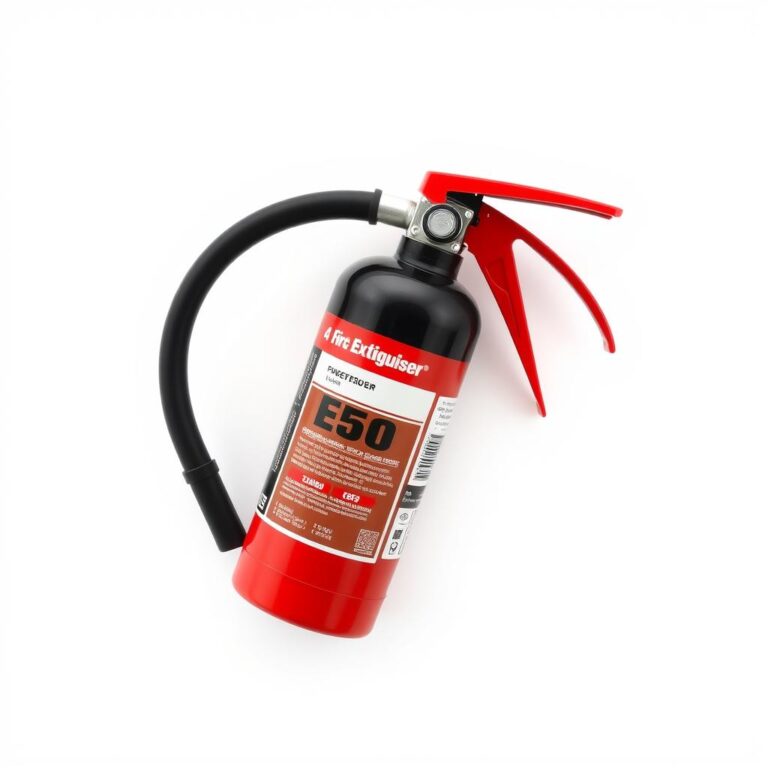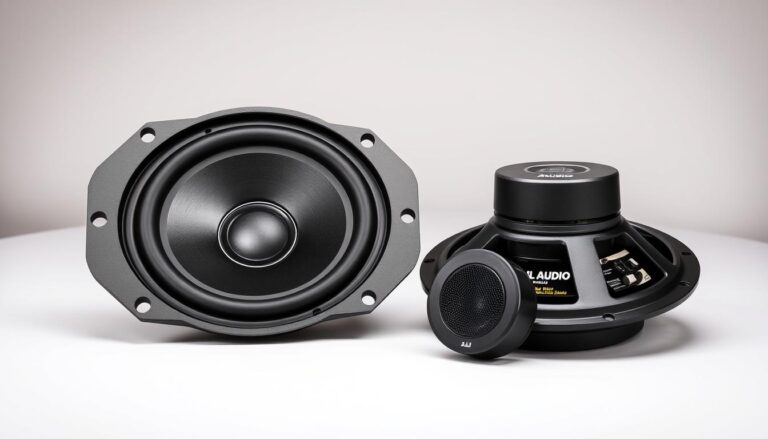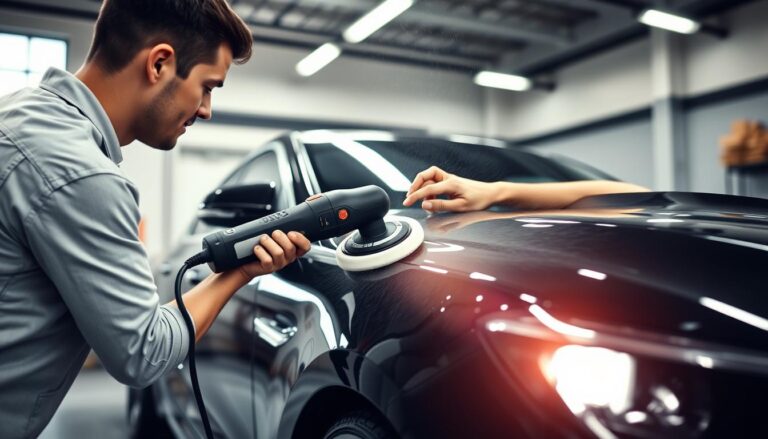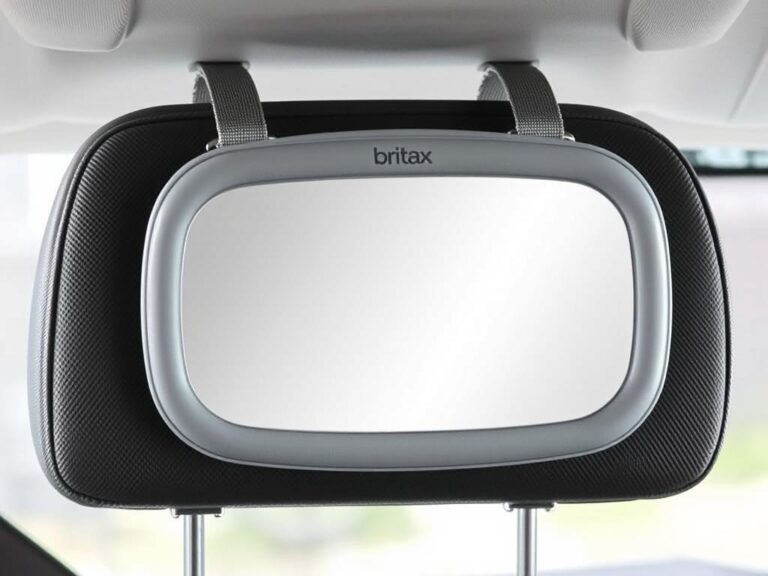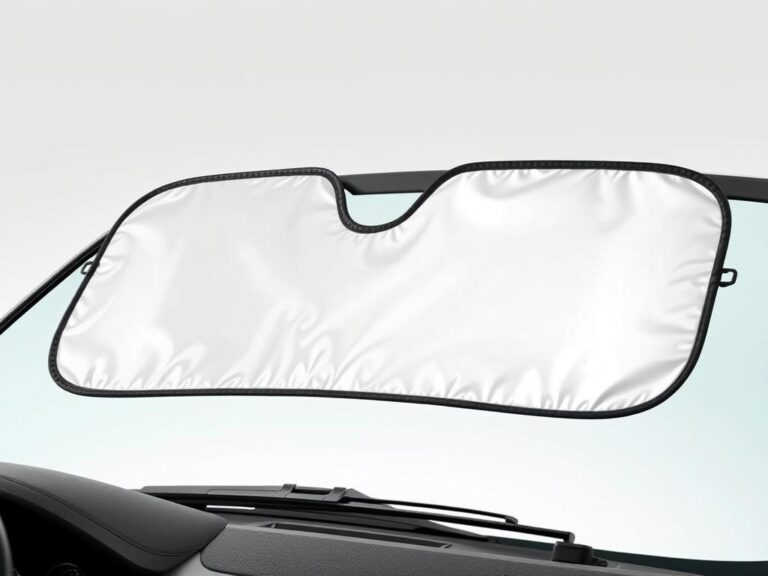Best Car Seat for Airplane in 2025 — Lightweight, FAA-Approved, Easy Installation
When you’re traveling with children, finding the right car seat for airplane use can make the difference between a stressful journey and a smooth flight. As a parent, you need a seat that’s not only FAA-approved but also lightweight enough to carry through busy terminals while managing luggage and children. The best car seat for airplane travel combines portability, ease of installation, and comfort for your little one during those long flights.
We’ve evaluated dozens of travel-friendly car seats based on verified weight specifications, FAA certification, installation methods, user feedback on airline compatibility, and overall value. Our comprehensive guide will help you choose the perfect airplane car seat that meets safety standards while making your family travel experience significantly easier.
As an Amazon Associate, we earn from qualifying purchases.
Top 10 Car Seats for Airplane Travel Compared
| Product | Best For | Weight | Installation | FAA Certification | Price Range | Action |
| WAYB Pico (Editor’s Choice) | Frequent flyers | 8 lbs | LATCH + seatbelt | Yes | $320-$380 | Check Price on Amazon |
| Cosco Scenera NEXT | Budget travelers | 8.8 lbs | Seatbelt | Yes | $55-$70 | Check Price on Amazon |
| Doona Infant Car Seat | Infants & airport convenience | 16.5 lbs | European belt path | Yes | $550-$600 | Check Price on Amazon |
| Evenflo Sonus 65 | Extended use | 11.5 lbs | LATCH + seatbelt | Yes | $120-$150 | Check Price on Amazon |
| Maxi-Cosi Romi | Comfort-focused travelers | 7.8 lbs | LATCH + seatbelt | Yes | $130-$150 | Check Price on Amazon |
| Evenflo Shyft DualRide | Infant travel system | 18.7 lbs | European belt path | Yes | $350-$400 | Check Price on Amazon |
| Nuna PIPA urbn | Urban travelers | 9 lbs | Rigid LATCH | Yes | $350-$400 | Check Price on Amazon |
| Safety 1st Jive | Value-conscious families | 8.3 lbs | LATCH + seatbelt | Yes | $85-$110 | Check Price on Amazon |
| Cosco Finale DX | Older toddlers | 8.4 lbs | LATCH + seatbelt | Yes | $80-$100 | Check Price on Amazon |
| Graco Contender Slim | Narrow airplane seats | 15.2 lbs | LATCH + seatbelt | Yes | $140-$170 | Check Price on Amazon |
Editor’s Choice: WAYB Pico
The WAYB Pico stands out as our top choice for airplane travel due to its revolutionary design that combines lightweight portability with FAA-approved safety. At just 8 pounds, it’s one of the lightest forward-facing car seats available, making it ideal for navigating busy airports while managing other luggage and children.
What truly sets the Pico apart is its unique folding capability—it collapses into a compact package that can fit in overhead bins or under seats when not in use. This innovative design makes the transition from airport to airplane to rental car remarkably smooth compared to traditional bulky car seats.
| Specification | Details |
| Weight | 8 lbs |
| Dimensions | 14.5″ W × 18.5″ H × 14.5″ D (unfolded) |
| Child Weight Range | 22-50 lbs |
| Child Height Range | 30-45 inches |
| Installation | LATCH system and seat belt compatible |
| FAA Certification | Yes |
| Folded Size | 14.5″ W × 11.6″ H × 18.9″ D |
| Warranty | 2 years |
Pros
- Ultra-lightweight at only 8 pounds
- Folds compactly for easy storage
- Breathable mesh fabric keeps children comfortable
- Aircraft-grade aluminum frame for durability
- Quick and intuitive installation
Cons
- Higher price point than other travel options
- Forward-facing only (not for infants)
- Limited recline options for sleeping
- Minimum weight requirement of 22 pounds
Parents consistently praise the WAYB Pico for its game-changing portability. Many report that it’s transformed their travel experience, allowing them to bring a car seat on flights when they previously would have risked checking one. The installation receives high marks for simplicity, though some users note there’s a learning curve to master the most secure fit.
The main drawback mentioned in user feedback is the limited recline, which can make it challenging for children to sleep comfortably on long flights. Additionally, the premium price point is a consideration, though many frequent travelers find the investment worthwhile for the convenience it provides.
Ready for stress-free travel with your child?
The WAYB Pico combines lightweight design with FAA-approved safety features to make air travel with kids significantly easier.
Best Budget Option: Cosco Scenera NEXT
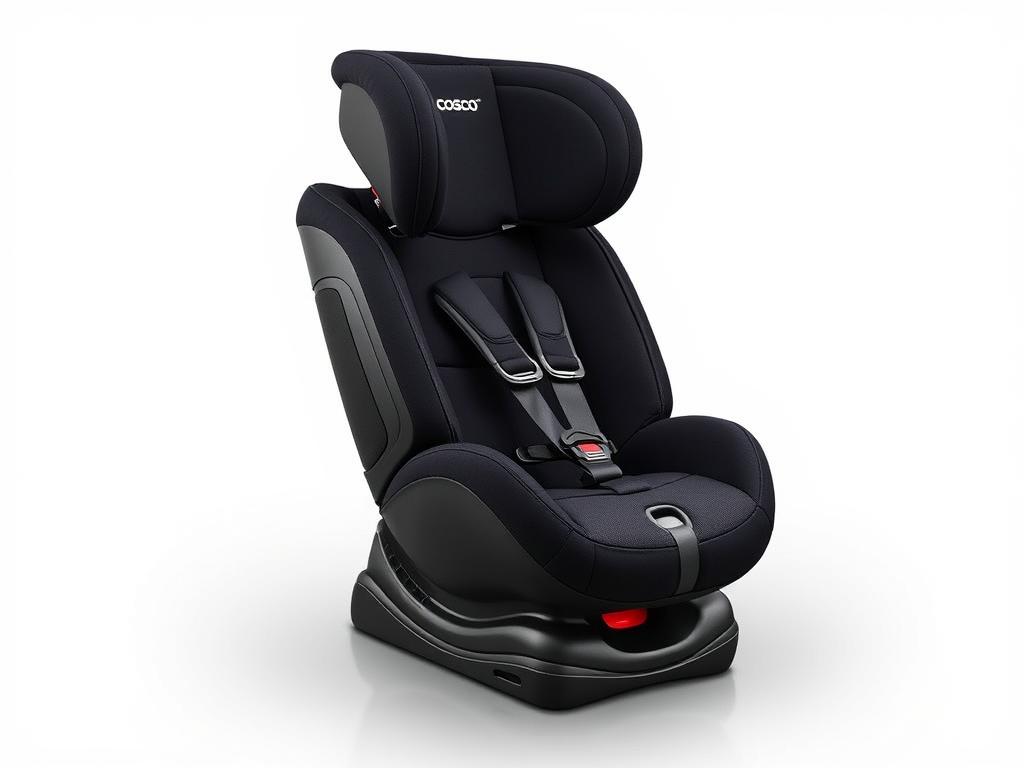
The Cosco Scenera NEXT has earned its reputation as the go-to budget option for air travel with children. At under $70 and weighing just 8.8 pounds, it offers exceptional value for occasional travelers or families who need a dedicated travel seat without breaking the bank.
This convertible car seat can be used both rear-facing (5-40 lbs) and forward-facing (22-40 lbs), making it versatile for different ages. Its compact design fits well on standard airplane seats and can be installed using the aircraft seat belt in compliance with FAA regulations.
| Specification | Details |
| Weight | 8.8 lbs |
| Dimensions | 17.5″ W × 22.5″ H × 23.5″ D |
| Rear-Facing Weight Range | 5-40 lbs |
| Forward-Facing Weight Range | 22-40 lbs |
| Height Limit | Up to 43 inches |
| Installation | Seat belt and LATCH compatible |
| FAA Certification | Yes |
| Cover | Machine washable and dryer safe |
Pros
- Extremely budget-friendly
- Lightweight and easy to carry
- Fits well on airplane seats
- Machine-washable cover
- Both rear and forward-facing capabilities
Cons
- Installation can be challenging
- Limited padding for comfort
- Harness straps may twist easily
- Lower maximum weight limit than other options
Users consistently highlight the Scenera NEXT’s value proposition—it’s often purchased specifically as a travel car seat while a more premium seat remains at home. Parents appreciate its lightweight design when navigating airports and the fact that the cover can be completely removed and machine washed after travel.
The most common criticism centers around installation difficulties. Many users recommend practicing the installation several times before travel and watching tutorial videos to master the “inside-out” installation technique that makes achieving a secure fit much easier.
Travel on a budget without compromising safety
The Cosco Scenera NEXT offers FAA-approved protection at an unbeatable price point for occasional travelers.
Best for Infants: Doona Infant Car Seat
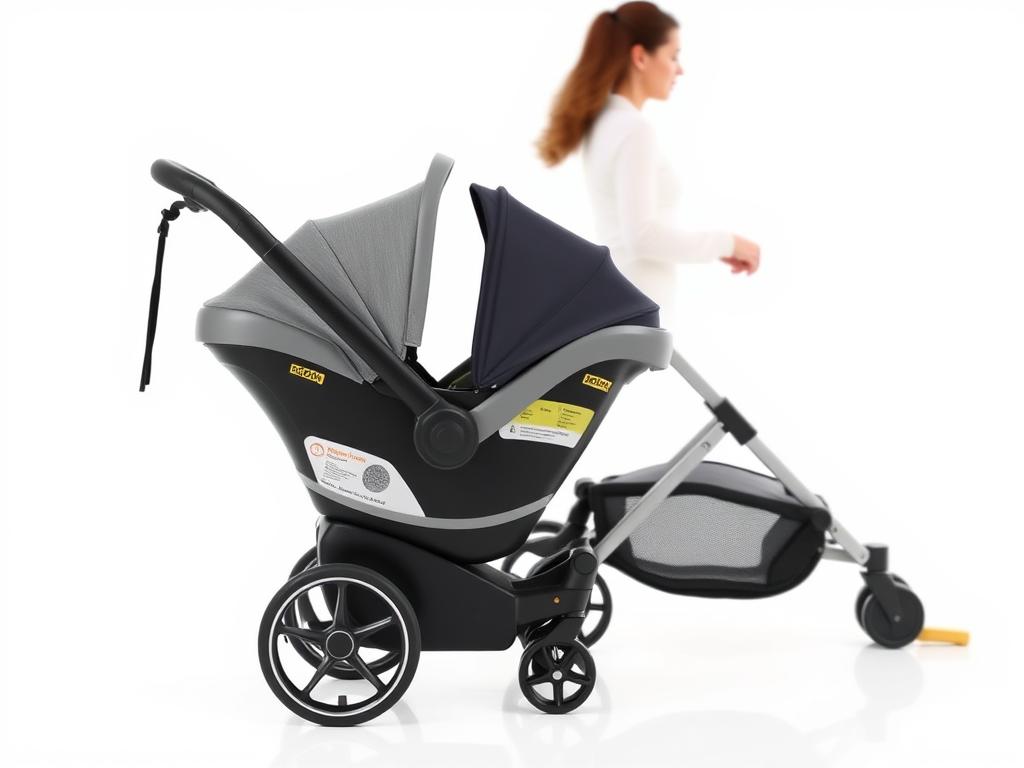
The Doona revolutionized infant travel with its ingenious integrated wheels that transform it from car seat to stroller in seconds. This unique design eliminates the need to carry a separate stroller through the airport, making it exceptionally convenient for air travel with infants up to approximately 12 months.
While heavier than traditional infant seats at 16.5 pounds, the Doona’s wheels mean you’ll rarely need to carry it—simply roll it through the airport, up to the aircraft door, then collapse the wheels to install it on the airplane seat. This innovative approach has made it a favorite among frequent-flying families with infants.
| Specification | Details |
| Weight | 16.5 lbs |
| Dimensions (Car Seat Mode) | 17.3″ W × 26″ H × 28.5″ D |
| Dimensions (Stroller Mode) | 17.3″ W × 39″ H × 32.3″ D |
| Weight Range | 4-35 lbs |
| Height Limit | Up to 32 inches |
| Installation | European belt path (baseless) |
| FAA Certification | Yes |
| Warranty | 2 years |
Pros
- Integrated wheels eliminate need for separate stroller
- One-second transformation between modes
- FAA-approved for air travel
- European belt path for secure baseless installation
- Premium materials and construction
Cons
- Heavier than standard infant seats
- Premium price point
- Limited storage space
- Outgrown relatively quickly as baby grows
Parents who travel frequently with infants consistently praise the Doona for its convenience. The ability to wheel directly from the terminal to the aircraft door without transferring the baby between devices is frequently cited as “game-changing.” Many users report that flight attendants are familiar with the Doona and often help with boarding.
The main considerations are the higher price point and the fact that babies typically outgrow it around 12 months. However, for families who travel regularly during their child’s first year, many find the investment worthwhile for the significant convenience it provides during a challenging travel period.
Simplify air travel with your infant
The Doona’s innovative car seat-to-stroller design makes airport navigation remarkably easier with babies under one year.
Best for Extended Use: Evenflo Sonus 65
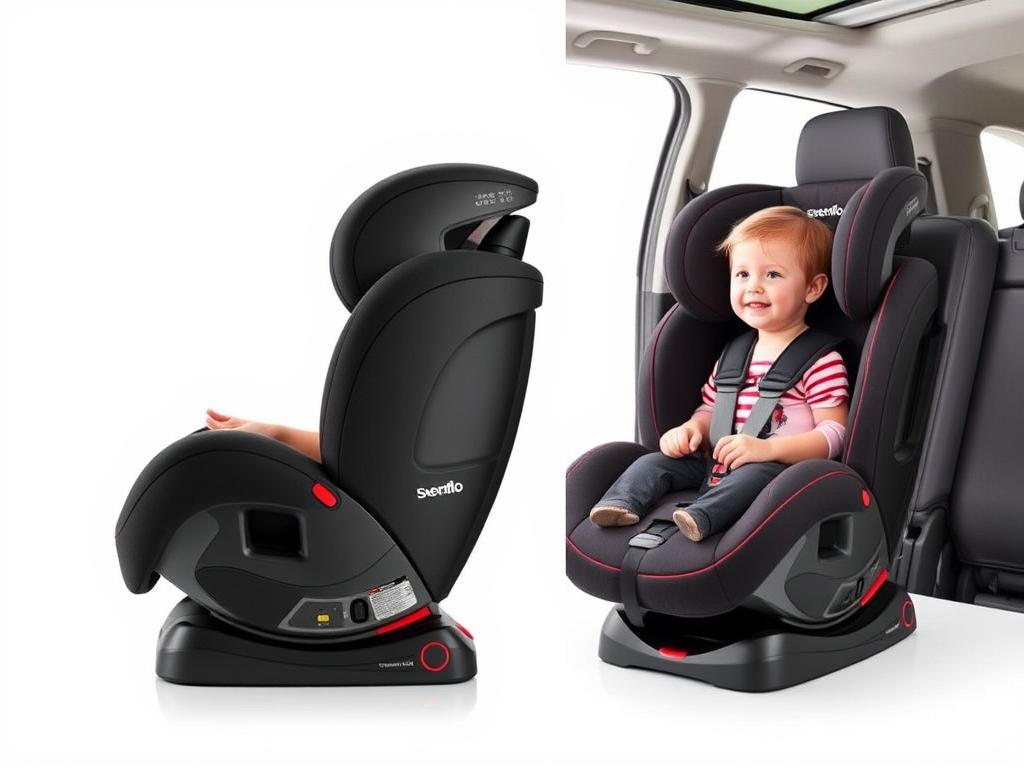
The Evenflo Sonus 65 offers exceptional value for families seeking a single travel car seat that will last for years. With its extended weight range (5-65 lbs) and taller harness height, it accommodates children from infancy through early elementary years, potentially serving as the only travel car seat you’ll need to purchase.
At 11.5 pounds, it strikes a good balance between durability and portability. While not the lightest option, its extended usability makes it a practical choice for families who travel occasionally and want to maximize their investment in a travel-specific car seat.
| Specification | Details |
| Weight | 11.5 lbs |
| Dimensions | 19″ W × 28″ H × 22″ D |
| Rear-Facing Weight Range | 5-40 lbs |
| Forward-Facing Weight Range | 22-65 lbs |
| Height Limit | Up to 50 inches |
| Installation | LATCH and seat belt compatible |
| FAA Certification | Yes |
| Harness Height | Up to 18 inches |
Pros
- Extended weight range (5-65 lbs)
- Taller harness height fits older children
- Relatively lightweight for its capabilities
- Built-in ventilation for comfort
- Budget-friendly for its longevity
Cons
- Wider profile than some travel seats
- Heavier than ultralight options
- Limited recline positions
- Cushioning could be more plush
Parents appreciate the Sonus 65’s versatility and extended usability. Many report using it from infancy through preschool years for travel, making it an economical choice. The seat receives positive feedback for its relatively straightforward installation on aircraft and adequate comfort for longer flights.
Some users note that while it’s not the lightest option, the trade-off for extended use makes it worthwhile. The wider profile can occasionally be challenging on smaller aircraft, but most users report successful installations across various airplane types.
One travel car seat for years of use
The Evenflo Sonus 65 grows with your child from infant to early elementary years, providing consistent safety for all your family travels.
Best for Comfort: Maxi-Cosi Romi
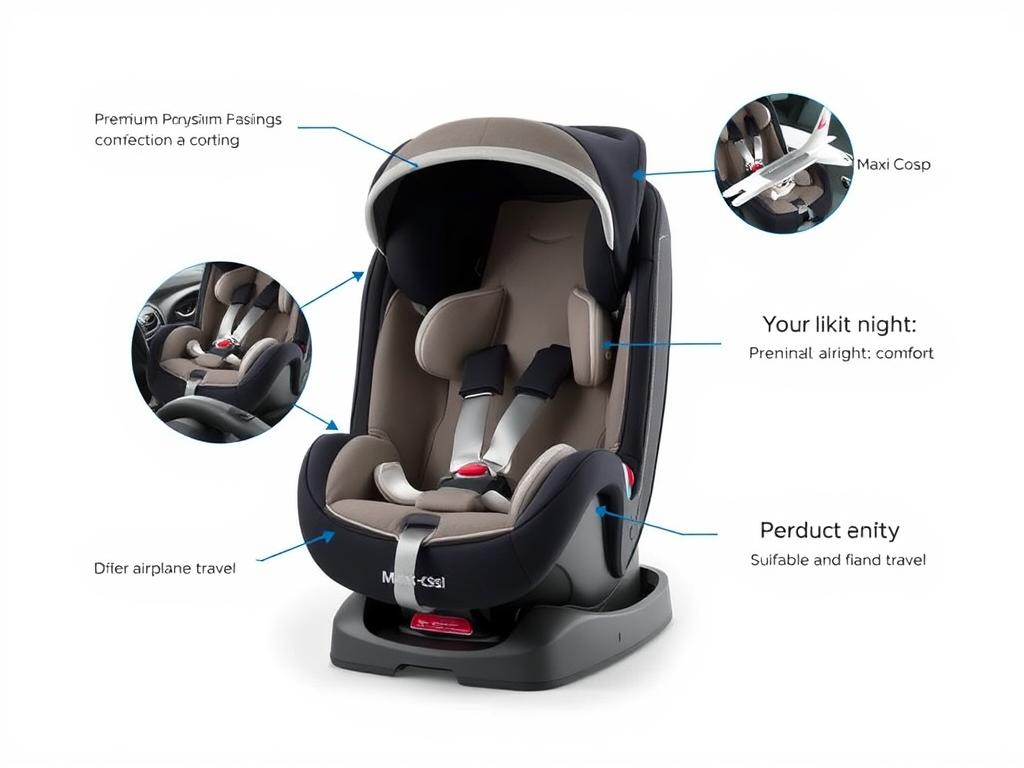
The Maxi-Cosi Romi stands out for combining exceptional lightweight design (just 7.8 lbs) with premium comfort features that make it ideal for long flights. This convertible seat uses high-quality, non-chemical flame retardant materials and extra padding to keep children comfortable during extended travel periods.
As a cousin to the budget-friendly Cosco Scenera NEXT (both made by the same parent company), the Romi offers significant comfort upgrades while maintaining impressive portability. For families who travel frequently or take long-haul flights, these comfort enhancements can make a meaningful difference in your child’s travel experience.
| Specification | Details |
| Weight | 7.8 lbs |
| Dimensions | 17″ W × 24″ H × 23.5″ D |
| Rear-Facing Weight Range | 5-40 lbs |
| Forward-Facing Weight Range | 22-40 lbs |
| Height Limit | Up to 43 inches |
| Installation | Premium LATCH connectors and seat belt |
| FAA Certification | Yes |
| Materials | Non-chemical flame retardant fabrics |
Pros
- Ultra-lightweight at 7.8 lbs
- Premium padding for extended comfort
- Non-chemical flame retardant materials
- Machine-washable and dryer-safe cover
- Premium LATCH connectors for easier installation
Cons
- Higher price point than basic travel seats
- Lower forward-facing weight limit (40 lbs)
- Installation has learning curve
- Limited recline options
Parents consistently highlight the Romi’s superior comfort compared to other lightweight travel options. Many report that children who struggled to sleep in other travel seats can nap more comfortably in the Romi during flights. The premium materials also receive praise from families concerned about chemical exposure.
Like its cousin the Scenera NEXT, users note there’s a learning curve to installation, but the premium LATCH connectors make car installations easier. The main consideration is the relatively low 40-pound forward-facing limit, which means children may outgrow it earlier than some alternatives.
Premium comfort in an ultra-lightweight design
The Maxi-Cosi Romi combines exceptional portability with premium comfort features for happier travelers on long flights.
How to Choose the Best Car Seat for Airplane Travel
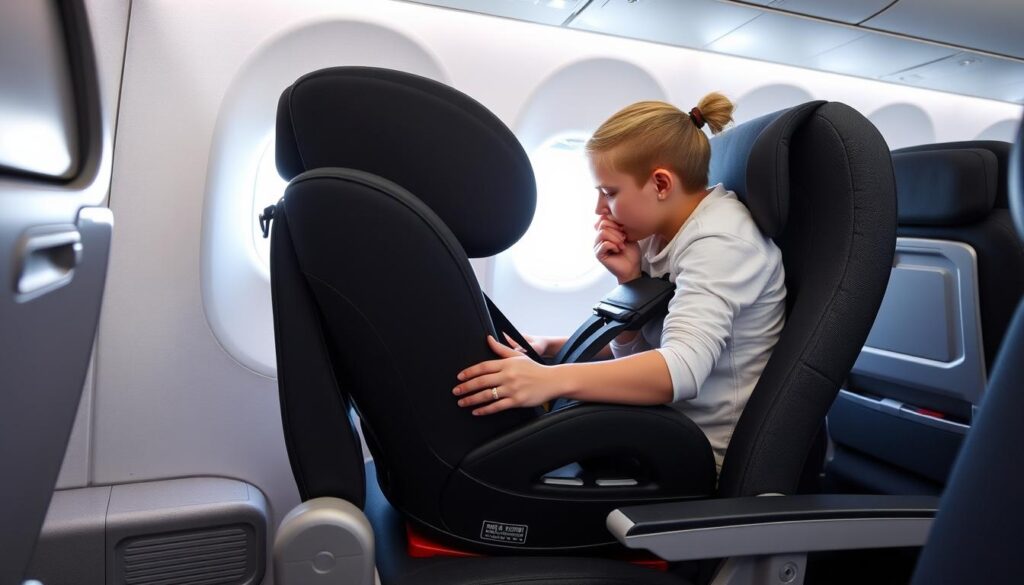
FAA Certification
The most critical requirement for any airplane car seat is FAA approval. Look for a label on the seat that states it is “certified for use in motor vehicles and aircraft.” Without this certification, flight attendants may not allow you to use the seat on the plane. Fortunately, most car seats manufactured in the US are FAA-approved when used with their internal harness.
Important: Booster seats that use the vehicle’s seat belt system are NOT approved for airplane use since aircraft only have lap belts.
Weight and Portability
When traveling, every pound matters. Consider these weight categories:
- Ultra-lightweight (under 8 lbs): Ideal for frequent travelers or when you’ll be carrying the seat long distances (Maxi-Cosi Romi, WAYB Pico)
- Lightweight (8-12 lbs): Good balance of portability and features (Cosco Scenera NEXT, Safety 1st Jive)
- Standard (12-18 lbs): Consider a travel cart for these heavier options (Graco Contender Slim)
- Integrated systems: Seats like the Doona with built-in wheels offset their weight with enhanced mobility
Size and Airplane Compatibility
Most economy airplane seats are approximately 16-18 inches wide. To ensure your car seat fits:
- Choose seats with a base width of 17 inches or less for the best fit
- Consider how the armrests on the airplane seat might affect installation
- Remember that rear-facing installations require more space front-to-back
Age and Size Appropriateness
Select a seat that matches your child’s age, weight, and height:
- Infants (0-12 months): Infant-specific seats like the Doona or convertible seats used rear-facing
- Toddlers (1-3 years): Lightweight convertible seats or specialized travel seats like the WAYB Pico (if over 22 lbs)
- Preschoolers (3-5 years): Forward-facing harnessed seats with higher weight limits
- School-age (5+ years): Consider whether your child still needs a car seat on the plane or can use the aircraft seat belt
Installation Method
On aircraft, you’ll be using the airplane seat belt for installation, but consider these factors:
- Seats with clear belt paths make airplane installation easier
- For infant seats, those with European belt path options provide more secure baseless installations
- Practice installation before your trip to identify any challenges
- Consider how you’ll install the seat at your destination (LATCH vs. seat belt)
Additional Features Worth Considering
- Foldability: Seats like the WAYB Pico that fold for storage
- Integrated mobility: The Doona and Evenflo Shyft DualRide with built-in wheels
- Comfort padding: Important for longer flights
- Cup holders: Convenient but may add width
- Machine-washable covers: Valuable for cleaning after travel
Price vs. Value
Travel car seats range widely in price:
- Budget ($50-$100): Basic but functional options like the Cosco Scenera NEXT
- Mid-range ($100-$200): Enhanced features and comfort (Evenflo Sonus 65, Maxi-Cosi Romi)
- Premium ($200-$400): Specialized travel features like folding (WAYB Pico)
- Luxury ($400+): Integrated systems with multiple functions (Doona)
Consider how frequently you’ll travel and how long you’ll use the seat when determining your budget. Frequent travelers often find premium options worth the investment, while occasional travelers may prefer budget-friendly choices.
Getting Your Car Seat Through the Airport
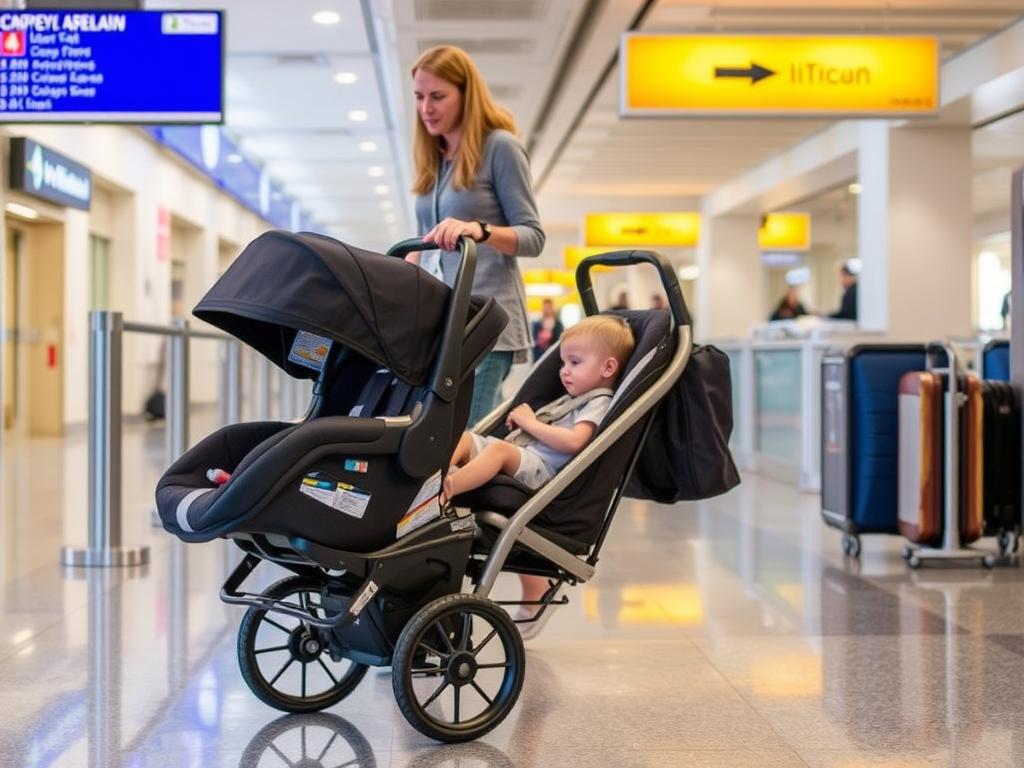
Even the lightest car seat can become cumbersome when navigating a busy airport with children and luggage. Here are the most effective options for transporting your car seat:
Car Seat Travel Carts
These wheeled carts attach to your car seat, allowing you to pull it through the airport with your child securely buckled inside. Popular options include:
- GoGoBabyz Travelmate: The most popular and durable option
- Britax Travel Cart: Designed specifically for Britax seats but works with many others
- Mountain Buggy Bagrider: Converts your suitcase into a travel cart
Backpack Carriers
For lighter car seats, backpack carriers free up your hands while transporting the seat:
- J.L. Childress Backpack: Fits most convertible car seats
- WAYB Pico Travel Bag: Specifically designed for the Pico
- Padded backpacks: Provide protection if you must check your seat
Stroller Compatibility
For infant seats, using a compatible stroller is often the easiest solution:
- Use your travel system stroller if space permits
- Consider lightweight travel strollers that accept infant car seats
- The Doona and Evenflo Shyft DualRide eliminate this need with built-in wheels
Gate Checking vs. Carrying On
While you can gate check a car seat for free on most airlines, we recommend bringing FAA-approved seats onboard whenever possible:
- Car seats can be damaged during handling, potentially compromising safety
- Having your seat on board ensures it’s not lost or delayed
- Your child will likely be more comfortable and secure in their familiar seat
If you must check your car seat, use a padded travel bag and consider taking photos before check-in to document its condition.
Installing Your Car Seat on an Airplane
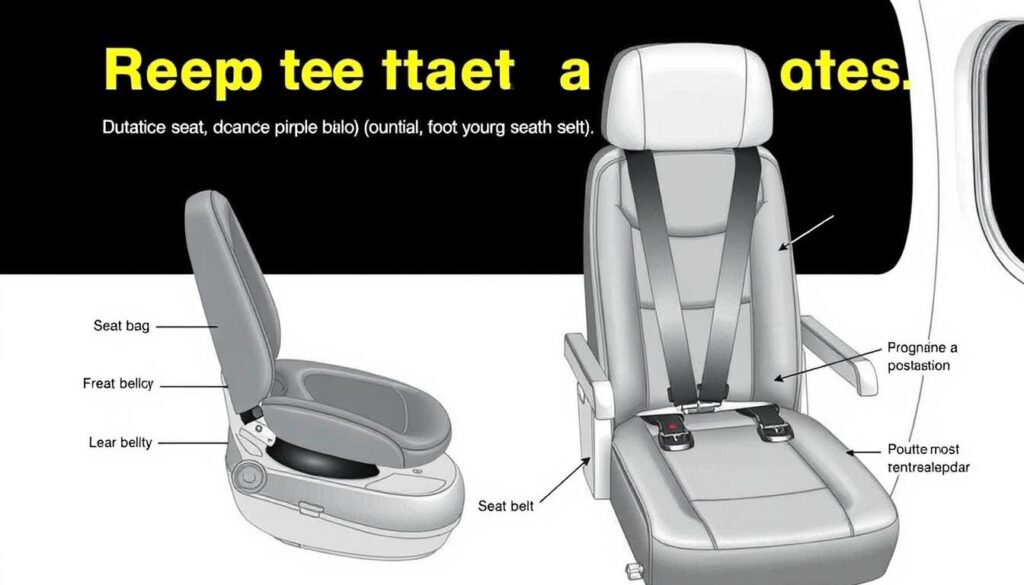
Installing a car seat on an airplane differs from installation in a vehicle. Here’s how to ensure a secure fit:
Forward-Facing Installation
- Raise the armrests if possible to provide more space
- Place the car seat in the window seat (never block another passenger’s access to the aisle)
- Thread the airplane seat belt through the forward-facing belt path
- Buckle and tighten the seat belt while pressing down firmly on the car seat
- Check for movement—the seat should not move more than one inch side-to-side or front-to-back
Rear-Facing Installation
- Inform the passengers in front that you’ll be installing a rear-facing seat (they may not be able to recline)
- Place the car seat in the window seat
- Adjust the recline angle according to manufacturer instructions
- Thread the airplane seat belt through the rear-facing belt path
- Buckle and tighten while pressing the seat into the aircraft seat
- Check for secure installation with minimal movement
Common Installation Challenges
- Inflexible airplane seat belts: Request a seat belt extender if needed
- Fixed armrests: Some aircraft have immovable armrests that may complicate installation
- Seat belt airbags: Present on some newer aircraft and may not be compatible with car seats (ask to be reseated)
- Limited space: Rear-facing installations may not fit in all aircraft rows
Pro Tip: Board early when traveling with a car seat. Most airlines offer pre-boarding for families with young children, giving you extra time to install your seat properly without holding up other passengers.
Frequently Asked Questions
Are all car seats allowed on airplanes?
No, only car seats that are FAA-approved can be used on aircraft. Look for a sticker on your car seat that states it is “certified for use in motor vehicles and aircraft.” Most car seats manufactured in the US that use an internal harness system are FAA-approved. Booster seats that require a shoulder belt cannot be used on airplanes since aircraft only have lap belts.
Do I need to buy a separate airplane seat for my infant?
While children under 2 can legally fly as lap infants in the US, the FAA strongly recommends purchasing a seat and using an approved car seat for all children regardless of age. This provides significantly better protection during turbulence or emergency situations. If you don’t purchase a seat, you can still bring your car seat to the gate and use it if there happens to be an empty seat available.
Which car seats fit best on airplane seats?
Car seats with a base width of 17 inches or less typically fit best on standard economy airplane seats, which are usually 16-18 inches wide. The WAYB Pico (14.5″ wide), Cosco Scenera NEXT (17.5″ wide), and Maxi-Cosi Romi (17″ wide) are among the best options for airplane compatibility. Raising the armrest, when possible, can provide additional space for slightly wider seats.
Can I check my car seat with my luggage?
While you can check a car seat as luggage (usually for free), we don’t recommend it. Checked car seats can be damaged during handling, potentially compromising their safety. If you must check your car seat, use a padded car seat travel bag and consider taking photos before check-in to document its condition. Gate-checking provides slightly better protection than checking with regular luggage.
What’s the difference between a travel car seat and a regular car seat?
Travel car seats are designed with portability in mind—they’re typically lighter (under 12 pounds), more compact, and sometimes have special features like folding capabilities (WAYB Pico) or integrated mobility (Doona). Regular car seats often prioritize additional comfort features, extended use ranges, or enhanced safety features that add weight and bulk. All car seats sold in the US must meet the same safety standards, so travel seats aren’t less safe—they just prioritize different features.
Should I rent a car seat at my destination instead of bringing one?
We generally don’t recommend renting car seats. Rental car seats often have unknown histories, may be installed incorrectly, could be outdated models, or might even be missing parts. Additionally, the specific seat you need might not be available upon arrival despite reservations. Bringing your own car seat ensures you have a seat you trust and know how to install properly.
Can I use my car seat on international flights?
FAA-approved car seats are generally accepted on international carriers, but policies can vary by airline. When booking international flights, confirm the airline’s car seat policy in advance. Some international airlines have specific size restrictions or may only allow car seats in certain aircraft or seating classes. Also consider whether your car seat will be compatible with vehicles at your international destination, as installation methods may differ.
Final Thoughts: Choosing the Right Airplane Car Seat
Selecting the best car seat for airplane travel depends on your specific travel needs, your child’s age and size, and how frequently you fly. After thorough evaluation, our top recommendations are:
- Best Overall: The WAYB Pico combines exceptional portability with innovative folding design, making it ideal for frequent travelers with toddlers and preschoolers.
- Best Budget Option: The Cosco Scenera NEXT offers remarkable value with its lightweight design and versatile installation options at an unbeatable price point.
- Best for Infants: The Doona’s integrated wheels transform the airport experience for parents of babies under one year.
- Best for Extended Use: The Evenflo Sonus 65 provides years of use with its higher weight limits and taller harness height.
- Best for Comfort: The Maxi-Cosi Romi delivers premium padding and non-chemical materials in an ultra-lightweight package.
Remember that the safest car seat is one that fits your child properly, installs correctly in your aircraft seat, and that you’ll actually use. Consider practicing installation before your trip and familiarizing your child with the seat if it’s different from their everyday car seat.
With the right car seat and preparation, flying with children becomes significantly more manageable, allowing your family to explore the world with greater ease and safety.
Ready to make air travel with your child easier?
Browse our top recommendations for FAA-approved, travel-friendly car seats that combine safety with convenience.

